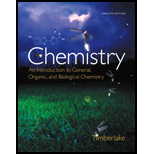
Write a one-sentence definition for each of the following:
a. chemistry
b. chemical
Interpretation:
The following terms should be defined:
- Chemistry
- Chemical
Answer to Problem 1.1QAP
Solution:
- Chemistry: The branch of science in which we study the composition, properties and structure of a substance or chemical or matter.
- Chemical: A chemically pure substance which has the same composition and properties irrespective of source, or mode of production.
Explanation of Solution
Chemistry: In this branch of science we study the nature of matter including properties, structure, composition, synthesis. We also study the way chemicals interact with each other and their surroundings. It is a general perception to link chemistry or study of chemicals to laboratory. However chemistry is present everywhere around us. Being photosynthesis, or respiration, or digestion, or food cooking, or corrosion of metals, etc.
Chemical: The chemical is a substance (pure) which will have the same composition irrespective of the source, it means water will always have two hydrogen atoms and one oxygen atom whether we are taking it from the river, sea, rain etc. The chemical formula will remain the same H2O.
We can define chemistry as that branch of science which deals with the study of chemicals, their properties, their structure, synthesis and interaction with other chemicals. Where, chemicals are pure substance which will have a distinct composition (made of same type of and same number of elements) irrespective of the source.
Want to see more full solutions like this?
Chapter 1 Solutions
EBK CHEMISTRY
Additional Science Textbook Solutions
Chemistry: Structure and Properties (2nd Edition)
Campbell Biology in Focus (2nd Edition)
Physics for Scientists and Engineers: A Strategic Approach, Vol. 1 (Chs 1-21) (4th Edition)
Genetic Analysis: An Integrated Approach (3rd Edition)
Biology: Life on Earth (11th Edition)
Campbell Biology (11th Edition)
- Stereochemistry: Three possible answers- diastereomers, enantiomers OH CH₂OH I -c=0 21108 1101 41745 HOR CH₂OH IL Но CH₂OH TIL a. Compounds I and III have this relationship with each other: enantiomers b. Compounds II and IV have this relationship with each other: c. Compounds I and II have this relationship with each other: d. *Draw one structure that is a stereoisomer of II, but neither a diastereomer nor an enantiomer. (more than one correct answer)arrow_forwardNonearrow_forwardPlease correct answer and don't use hand ratingarrow_forward
- In mass spectrometry, alpha cleavages are common in molecules with heteroatoms. Draw the two daughter ions that would be observed in the mass spectrum resulting from an alpha cleavage of this molecule. + NH2 Q Draw Fragment with m/z of 72arrow_forwardDon't used Ai solution and don't used hand raitingarrow_forwardIf 3.8 moles of Ca2 are consumed in this reaction, how many grams of H2O are needed?If 3.8 moles of Ca2 are consumed in this reaction, how many grams of H2O are needed?arrow_forward
- Don't used Ai solutionarrow_forwardWrite the systematic (IUPAC) name for each of the following organic molecules: F structure Br LL Br Br الحمد name ☐ ☐arrow_forwardDraw an appropriate reactant on the left-hand side of this organic reaction. Also, if any additional major products will be formed, add them to the right-hand side of the reaction. + + Х ง C 1. MCPBA Click and drag to start drawing a structure. 2. NaOH, H₂O Explanation Check OI... OH ol OH 18 Ar © 2025 McGraw Hill LLC. All Rights Reserved. Terms of Use | Privacy Center | Accessibilityarrow_forward
- Chemistry: Matter and ChangeChemistryISBN:9780078746376Author:Dinah Zike, Laurel Dingrando, Nicholas Hainen, Cheryl WistromPublisher:Glencoe/McGraw-Hill School Pub Co



 Introductory Chemistry: An Active Learning Approa...ChemistryISBN:9781305079250Author:Mark S. Cracolice, Ed PetersPublisher:Cengage Learning
Introductory Chemistry: An Active Learning Approa...ChemistryISBN:9781305079250Author:Mark S. Cracolice, Ed PetersPublisher:Cengage Learning General Chemistry - Standalone book (MindTap Cour...ChemistryISBN:9781305580343Author:Steven D. Gammon, Ebbing, Darrell Ebbing, Steven D., Darrell; Gammon, Darrell Ebbing; Steven D. Gammon, Darrell D.; Gammon, Ebbing; Steven D. Gammon; DarrellPublisher:Cengage Learning
General Chemistry - Standalone book (MindTap Cour...ChemistryISBN:9781305580343Author:Steven D. Gammon, Ebbing, Darrell Ebbing, Steven D., Darrell; Gammon, Darrell Ebbing; Steven D. Gammon, Darrell D.; Gammon, Ebbing; Steven D. Gammon; DarrellPublisher:Cengage Learning





